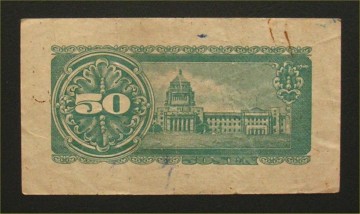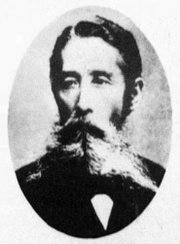 |
 |
Face value : 50 Sen 
Design : Portrait of Itagaki Taisuke
Issue : March, 1948 (Showa era, year 23), Abolition : December, 1953 (Showa era, year 28)
Size : 60mm X 108mm
|
 Itagaki Taisuke (1837 - 1919) was a Japanese politician who became a leader of the Freedom and People's Rights Movement (jiyu minken undo).
Itagaki Taisuke (1837 - 1919) was a Japanese politician who became a leader of the Freedom and People's Rights Movement (jiyu minken undo).
Itagaki Taisuke was born on April 17, 1837 in Tosa, Japan, into a middle-ranking samurai family. Following factional disputes, Itagaki emerged in the 1860s as the military leader of his district.
In the Meiji Restoration, Itagaki led Tosa's troops in support of the Emperor against Tokugawa. He became a councillor of state in 1869, after Tokugawa's defeat.
Itagaki resigned from the Meiji government in 1873 over disagreement with the government's policy of restraint toward Korea and, more generally, in opposition to Choshu-Satsuma political domination. In 1874 he formed the Risshisha (Society of Self-Reliance), declaring, "We, the thirty millions of people in Japan are all equally endowed with certain definite rights, among which are those of enjoying and defending life and liberty, acquiring and possessing property, and obtaining a livelihood and pursuing happiness. These rights are by Nature bestowed upon all men, and, therefore, cannot be taken away by the power of any man." Itagaki's involvement in liberalism lent it political legitimacy in Japan, and he became a leader of the push for democratic reform.
The anti-government stance of the Risshisha appealed to discontent with the Meiji regime. It gained early support from the remnants of the samurai class (shinzoku), and later from the rural aristocracy, who resented centralized taxation, and peasants, who were discontented with high prices and low wages.
The Aikokusha (Society of Patriots) was created in 1875 to broaden the influence of the liberal movement. After funding issues led to initial stagnation, the Aikokusha was revived in 1878 and agitated with increasing success.
The Movement drew the ire of the government and its supporters. In 1882, Itagaki was almost assassinated by a right-wing militant, to whom he then said, "Itagaki may perish, but liberty will survive."
Itagaki created the Liberal Party in 1881, which, along with the Kaishinto, led the nationwide popular discontent of 1880-1884. During this period, a rift developed in the movement between the lower class members and the aristocratic leadership of the party. Itagaki became embroiled in controversy when he took a trip to Europe believed by many to have been funded by the government. The trip turned out to have been provided by the Mitsui Company, but suspicions that Itagaki was being won over to the government side persisted. Consequently, radical splinter groups run by the peasantry proliferated, undermining the unity of the party and the Movement.
Following the Meiji government's promise in 1881 of a constitutional government by 1889, strict limitations on the right of assembly were introduced, and the Liberal Party dissolved itself on October 20, 1884. It was reestablished shortly before the opening of the Diet in 1890.
In 1898, Itagaki joined with Shigenobu Okuma of the Kaishinto to form a party government, serving as Home Minister. The Cabinet collapsed after squabbling between the parties, and demonstrated that parliamentary democracy in Japan remained immature and incapable of governance.
Itagaki retired from the Liberal Party in 1900. He died of natural causes in 1919.
As the Liberal Party was the first Japanese political party, Itagaki is credited as being the first Japanese party leader and an important force for liberalism in Meiji Japan.
|
Copyright © 2005-2020 Nippon Kindai Banknote. All Rights Reserved.
|